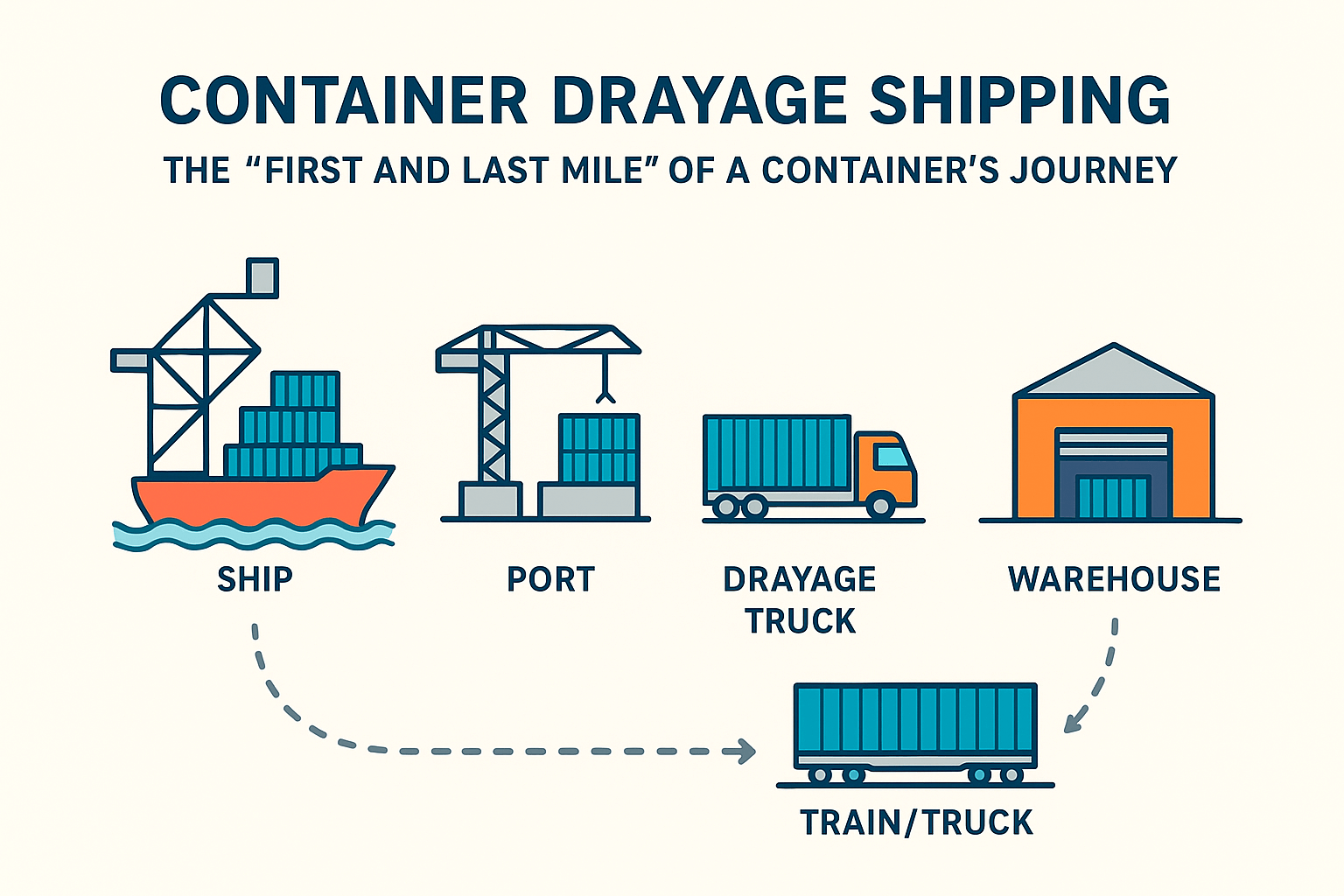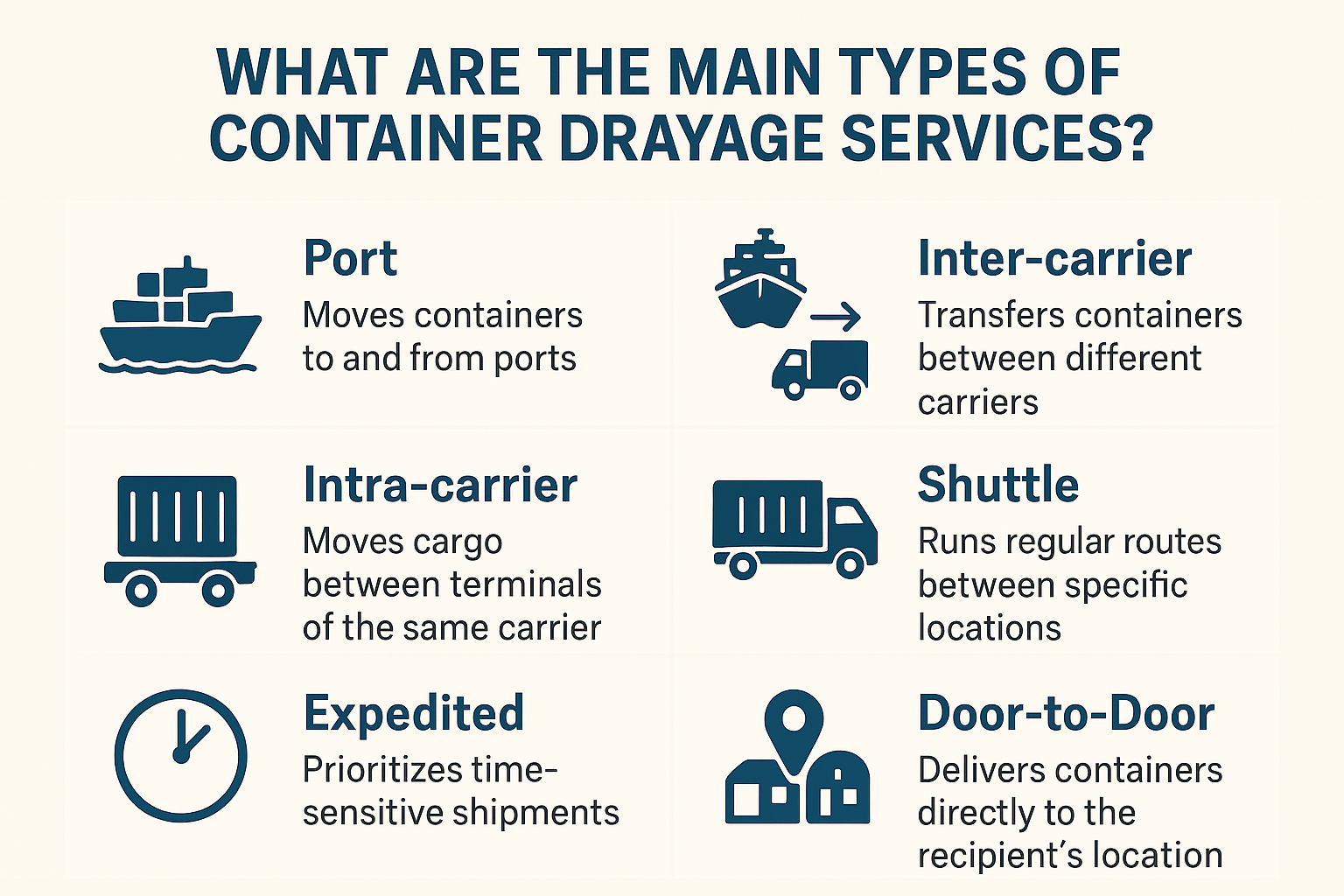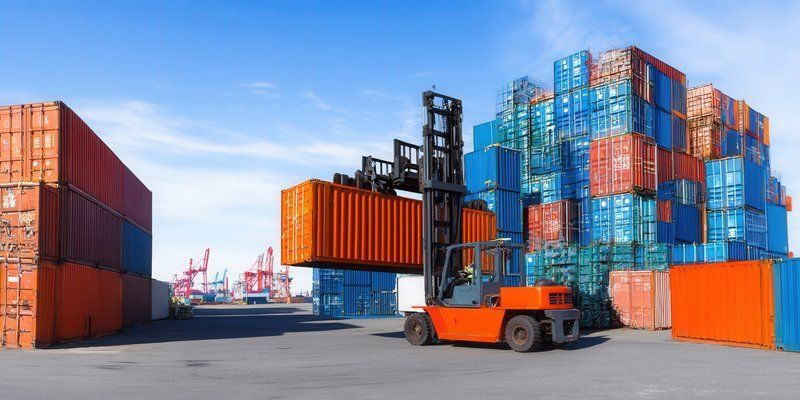Container drayage is the short-distance transport of shipping containers—a small step that can make a big difference in your shipping costs and timing. This guide explains how drayage works, its role in intermodal transport, and practical tips to save money. Whether you’re shipping cars or goods, you’ll learn how to move cargo efficiently and avoid extra fees.
Table of Content:
- What is Container Drayage Shipping?
- Why is Container Drayage Important in the Supply Chain?
- How Did Drayage Shipping Evolve?
- What Are the Main Types of Container Drayage Services?
- How Does Container Drayage Fit Into Intermodal Transportation?
- What Challenges Affect Container Drayage?
- How Can Third-Party Logistics (3PLs) Help With Drayage?
- How Does Container Drayage Impact Your Shipping Costs?
- How Can YK Freight Improve Your Drayage Experience?
- What Are Best Practices for Using Container Drayage Services?
- How Can You Optimize Your Supply Chain With Drayage?
What is Container Drayage Shipping?
Container drayage shipping is the short-distance transport of freight containers between key locations like ports, rail yards, warehouses, and distribution centers. Think of it as the “first and last mile” of a container’s journey: moving cargo from where it arrives—say, a ship at a port—to where it will be loaded onto a truck, train, or another facility. Without drayage, containers would sit idle at the port, causing delays and extra costs.

Drayage plays a vital role in intermodal transportation. Intermodal shipping uses multiple modes of transport—ships, trains, and trucks—to move goods efficiently. For example, a container carrying a used car might arrive at the Port of Los Angeles on a cargo ship. From there, a drayage truck picks it up and moves it to a nearby storage yard or rail terminal. Once at the next hub, the container can continue its journey by train or another truck to its final destination. This seamless handoff is what keeps the supply chain running smoothly.
For budget-conscious shippers, understanding container drayage can help save money. Imagine you’ve purchased a used car from an online auction on the East Coast. Instead of paying extra for multiple handling fees or unnecessary storage, a reliable drayage service can transport the container from the port directly to a local storage lot or even to your garage efficiently. This reduces unnecessary delays, lowers the risk of extra charges, and ensures your shipment stays on schedule—all without breaking your budget.
Why is Container Drayage Important in the Supply Chain?
Container drayage may cover a short distance, but it plays a critical role in the global supply chain. Often called the “last mile” of container shipping, drayage ensures that cargo moves quickly and efficiently from ports, rail yards, or warehouses to its next destination. Without this essential step, even the most carefully planned shipping operations can face delays, extra costs, and logistical headaches.
Smooth drayage helps every other part of the supply chain run more efficiently. For example, a delayed container at the port can cause a ripple effect: trucks may wait idle, warehouse space might fill up, and scheduled deliveries could be postponed. In contrast, an efficient drayage service keeps containers moving on time, helping shipping companies, warehouses, and ultimately customers stay on schedule.
For budget-conscious shippers, this is especially important. Imagine you’re importing a used car from a U.S. port like Miami. If the container isn’t picked up quickly and moved to a storage facility or distribution center, you could face extra fees for demurrage (charges for keeping a container at the port too long), additional storage costs, or even late delivery penalties. By using a reliable drayage service, such as YK Freight, your container is transported promptly, minimizing extra expenses and keeping your shipping process on track.
How Did Drayage Shipping Evolve?
Drayage shipping has a long history that dates back centuries, long before trucks and modern logistics existed. The term “drayage” comes from the word “dray,” which referred to a low, flat cart without sides, pulled by horses. These carts were used to move goods over short distances within towns or between ports and local markets. While effective for their time, horse-drawn drays were slow, limited in capacity, and prone to delays caused by weather, road conditions, or the stamina of the horses.
The evolution of drayage truly accelerated in the early twentieth century with the advent of trucks. Modern drayage trucks can carry heavy containers safely and efficiently over short distances, drastically reducing transit times compared to horse-drawn carts. Today, a container that once might have taken hours—or even a full day—to move can now be transported in minutes, with better tracking, safety, and scheduling.
For example, imagine importing a used car a century ago. Moving it from a busy port to a nearby warehouse might have taken hours of labor with multiple horses and carts. Today, the same car can be loaded into a container and picked up by a drayage truck that delivers it to a storage facility or dealership within minutes, all while being tracked and handled safely.
The evolution of drayage—from simple horse-drawn carts to modern trucking—is a clear example of how logistics has become faster, safer, and more reliable, benefiting both businesses and budget-conscious shippers. Modern drayage not only saves time but also reduces costs and minimizes the risk of delays or damage to cargo.
What Are the Main Types of Container Drayage Services?
Container drayage isn’t one-size-fits-all. Depending on your shipping needs, there are several types of drayage services, each designed to move cargo efficiently over short distances. Understanding these options can help budget-conscious shippers save money and avoid unnecessary fees. Here’s a breakdown of the main types:

Port Drayage
Port drayage involves moving containers directly from the port to a nearby facility, such as a warehouse or rail terminal. This is the most common type of drayage.
Example: If you’ve imported a used car to the Port of Los Angeles, port drayage ensures it’s quickly transported to a local storage yard without extra waiting fees.
Inter-carrier Drayage
Inter-carrier drayage moves containers between different carriers, such as from one shipping line to another. This is common when freight is switching from one trucking company to another for further transport.
Example: Your container of parts arrives via one carrier, but your local transporter is a different company. Inter-carrier drayage keeps your shipment moving smoothly.
Intra-carrier Drayage
Intra-carrier drayage occurs when a container moves between facilities of the same carrier. It helps consolidate shipments and streamline operations.
Example: A trucking company moves containers between its own depots to optimize loading schedules, reducing storage costs and transit time.
Expedited Drayage
Expedited drayage is for time-sensitive shipments that need priority handling. It’s slightly more expensive but saves valuable time.
Example: You need a vehicle or cargo delivered quickly to meet an auction or sale deadline. Expedited drayage ensures it arrives on time without unnecessary delays.
Shuttle Drayage
Shuttle drayage moves containers from one hub to another along a short route, often connecting ports with inland facilities. This is efficient for high-volume shipments.
Example: A car importer in New Jersey uses shuttle drayage to move multiple containers from the port to nearby warehouses efficiently.
Door-to-Door Drayage
Door-to-door drayage covers the entire short-distance journey from the origin facility (like a port) directly to the customer’s destination. This saves handling at intermediate facilities and can reduce overall costs.
Example: Importing a used car? Door-to-door drayage with YK Freight takes it straight from the port to your garage, avoiding extra fees at storage yards.
How Does Container Drayage Fit Into Intermodal Transportation?
Container drayage is a key link in the intermodal transportation chain, which involves moving goods using multiple modes of transport—ships, trucks, and trains—without unloading the cargo from its container. While long-distance shipping handles the bulk of the journey, drayage ensures that containers move efficiently between hubs, keeping the entire system running smoothly.
The intermodal process begins when a container arrives at a port, rail yard, or warehouse. Drayage trucks pick up the container and transport it to the next facility, whether that’s a rail terminal, a distribution center, or a local storage yard. Once there, the container may continue its journey by train, another truck, or even be delivered directly to a customer. Every handoff in this chain depends on precise scheduling and planning to avoid delays and extra fees.
For example, imagine a small car dealer who buys vehicles at an online auction on the East Coast. The cars arrive at a nearby port in containers. Without fast and reliable drayage, the dealer risks paying additional port storage fees or missing delivery deadlines, which could delay sales and increase costs. By using YK Freight’s drayage services, containers are transported quickly from the port to the dealer’s lot or warehouse, keeping the entire process on schedule and avoiding unnecessary expenses.
What Challenges Affect Container Drayage?
While container drayage may seem straightforward, it faces several real-world challenges that can impact efficiency, timing, and costs. One of the most common issues is traffic congestion around busy ports or rail yards. Even the fastest drayage trucks can get delayed when trucks queue at port gates or navigate crowded city streets.
Port delays are another frequent challenge. Containers can sit at terminals longer than expected due to labor shortages, customs inspections, or operational bottlenecks. These delays can quickly increase costs, especially for budget-conscious shippers who may have to pay demurrage or storage fees for containers that remain at the port too long.
Equipment shortages also affect drayage. Limited availability of drayage trucks, chassis, or handling equipment can slow down the movement of containers, creating backlogs and scheduling conflicts. Likewise, poor scheduling or lack of coordination between carriers can result in missed pickups, extra handling, and higher fees.
Proper planning and coordination are crucial to overcome these challenges. A reliable drayage provider like YK Freight helps shippers manage routes, schedules, and equipment availability to minimize delays.
For example, imagine you’re importing a used car to the Port of New York. Without careful scheduling, the container could sit at the port for several days, racking up extra charges while delaying delivery to your storage facility or dealership. By using YK Freight, the container is picked up on time, transported efficiently, and delivered without unnecessary costs.
How Can Third-Party Logistics (3PLs) Help With Drayage?
Third-party logistics providers, or 3PLs, are companies that specialize in managing different parts of the shipping and supply chain process. When it comes to container drayage, 3PLs like YK Freight play a crucial role in ensuring that cargo moves efficiently, safely, and cost-effectively.
3PLs bring expertise, technology, and resources that individual shippers often lack. Here are some key benefits of working with a trusted 3PL for drayage:
- Route Optimization: 3PLs plan the best paths for trucks to move containers quickly, avoiding traffic congestion and reducing fuel costs.
- Capacity Management: They ensure that the right number of trucks and chassis are available when needed, preventing delays due to equipment shortages.
- Customs Handling: For international shipments, 3PLs help manage paperwork and compliance, reducing the risk of costly fines or holdups.
- Tracking and Visibility: 3PLs provide real-time updates on container locations, so you always know where your cargo is.
- Demurrage and Detention Management: Experienced 3PLs monitor port timelines to minimize extra fees for containers sitting too long.
For budget-conscious shippers, partnering with a 3PL like YK Freight can save both time and money. For example, imagine shipping a used car from the Port of Miami. Without expert guidance, you might face delays due to scheduling errors, traffic, or equipment shortages, leading to extra storage fees or late delivery. With YK Freight, the container is picked up on time, handled efficiently, and delivered according to plan, avoiding unexpected costs and stress.
How Does Container Drayage Impact Your Shipping Costs?
Container drayage may cover only a short distance, but it can have a big effect on your overall shipping expenses. Drayage fees are charged for moving containers from ports, rail yards, or warehouses to the next destination. If not planned carefully, these fees can add up quickly, especially when containers sit idle due to delays or inefficient handling.
The good news is that there are several ways to reduce drayage costs without compromising delivery speed or safety. Some effective strategies include:
- Consolidating Shipments: Combining multiple containers or shipments into a single drayage run reduces the number of trips and lowers total costs.
- Scheduling Off-Peak Pickups: Picking up containers during non-peak hours avoids traffic delays and may come with lower service fees.
- Choosing the Right Type of Drayage: Selecting services like door-to-door drayage can eliminate extra handling and storage fees, saving money in the long run.
For example, imagine a customer importing several used cars at once. Instead of paying separate drayage fees for each container, they coordinate door-to-door drayage with YK Freight, moving all containers directly from the port to a local storage facility or dealership. This approach minimizes handling, avoids demurrage charges, and keeps overall shipping costs lower.
How Can YK Freight Improve Your Drayage Experience?
When it comes to container drayage, working with a reliable provider can make all the difference. YK Freight specializes in managing short-distance container transport efficiently, helping shippers save time, reduce costs, and avoid unnecessary delays.
Here’s how YK Freight can improve your drayage experience:
- Efficient Container Handling: YK Freight ensures containers are loaded, moved, and delivered safely, reducing the risk of damage and delays.
- Coordination with Warehouses: By coordinating with storage facilities and distribution centers, YK Freight ensures that containers arrive exactly where they’re needed, without extra handling or storage fees.
- Door-to-Door Delivery: For added convenience, YK Freight can transport containers directly from the port to your final destination, eliminating intermediate stops and saving both time and money.
- Support for Ecommerce or Vehicle Shipping: Whether you’re shipping products for an online store or importing vehicles, YK Freight offers tailored drayage solutions to meet your specific needs.
For example, imagine a budget-conscious individual shipping a used car from Los Angeles to New York. Without proper drayage services, the container could face delays at the port or extra storage fees during transit. By partnering with YK Freight, the car is transported directly and efficiently, avoiding unnecessary charges and ensuring it arrives on schedule.
What Are Best Practices for Using Container Drayage Services?
Container drayage is a crucial part of shipping, but handling it efficiently requires some planning—especially for budget-conscious shippers. By following a few best practices, you can save time, reduce fees, and avoid unnecessary stress.
1. Book in Advance
Scheduling drayage early helps secure trucks, drivers, and equipment when you need them. Early booking also reduces the risk of last-minute delays and higher fees, which can quickly add up.
2. Track Shipments
Using tracking tools provided by your drayage provider, like YK Freight, allows you to monitor containers in real time. This visibility helps you plan for arrivals, coordinate with warehouses, and avoid waiting or storage charges.
3. Consolidate Shipments
If you’re shipping multiple containers or products, consolidating them into a single drayage run can save money. Fewer trips mean lower fuel costs, fewer handling fees, and less risk of delays.
4. Communicate Clearly with Drayage Providers
Clear communication ensures that pickup times, delivery locations, and any special handling requirements are understood. Miscommunication can result in missed pickups, extra storage fees, or delays.
Example: Imagine you’re importing a used car and schedule the drayage around off-peak port hours. By coordinating with YK Freight, your container is picked up efficiently, avoiding demurrage fees and saving hundreds of dollars compared to an unplanned, last-minute pickup.
How Can You Optimize Your Supply Chain With Drayage?
Optimizing your supply chain starts with understanding the crucial role container drayage plays in moving cargo efficiently. Even though drayage covers short distances, smart planning and coordination can save significant time and money, especially for budget-conscious shippers.
One key strategy is combining drayage with other intermodal services. By coordinating truck, rail, and shipping schedules, you can reduce delays between handoffs and ensure cargo moves continuously. For example, containers can be picked up by drayage trucks at the port and delivered directly to a rail yard without unnecessary waiting, keeping the entire supply chain flowing smoothly.
Another important tactic is leveraging 3PL expertise. Companies like YK Freight specialize in route optimization, scheduling, and equipment management. Their knowledge helps minimize idle time at ports, prevents congestion, and ensures containers are handled efficiently.
Minimizing idle time is also crucial. Containers sitting at ports or warehouses incur extra fees and delay downstream operations. Proper coordination, real-time tracking, and planned pickups reduce these costs and keep shipments moving on time.
Further Reading:
Advantages of Container Drayage for Your Business
Container Drayage for Small Businesses in Atlanta: How to Get Started?






ASK YOUR QUESTIONS